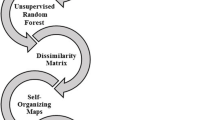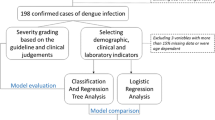Abstract
Even though the World Health Organization criteria’s for classifying the dengue infection have been used for long time, recent studies declare that several difficulties have been faced by the clinicians to apply these criteria. Accordingly, many studies have proposed modified criteria to identify the risk in dengue patients based on statistical analysis techniques. None of these studies utilized the powerfulness of the self-organized map (SOM) in visualizing, understanding, and exploring the complexity in multivariable data. Therefore, this study utilized the clustering of the SOM technique to identify the risk criteria in 195 dengue patients. The new risk criteria were defined as: platelet count less than or equal 40,000 cells per mm3, hematocrit concentration great than or equal 25% and aspartate aminotransferase (AST) rose by fivefold the normal upper limit for AST/alanine aminotransfansferase (ALT) rose by fivefold the normal upper limit for ALT. The clusters analysis indicated that any dengue patient fulfills any two of the risk criteria is consider as high risk dengue patient.







Similar content being viewed by others
References
Bandyopadhyay S, Lucy CS, Kroeger A (2006) Classifying dengue: a review of the difficulties in using the WHO case classification for dengue haemorrhagic fever. Trop Med Int Health 11(8):1238–1255
Celia C et al (2005) Comparison of clinical features and hematologic abnormalities between dengue fever and dengue hemorrhagic fever among children in the Philippines. Am Soc Trop Med Hyg 73(2):435–440
Davies DL, Bouldin DW (1979) A cluster separation measure. IEEE Trans Pattern Anal Mach Intell 1(2):224–227
Garceia HL, Machon I (2004) Self-organizing map and clustering for wastewater treatment monitoring. Eng Appl Artif Intell 17:215–225
Gubler DJ (1998) Dengue and dengue hemorrhagic fever. Clin Microbiol Rev 11:480–496
Gubler GJ (2002) Epidemic dengue/dengue hemorrhagic fever as a public health, social and economic problem in the 21st century. Trends Microbiol 10:100–103
Gubler DJ, Kuno G (1997) Dengue and dengue hemorrhagic fever. CAB International, Wallingford, UK
Hales S, de Wet N, Maindonald J, Woodward A (2002) Potential effect of population and climate changes on global distribution of dengue fever: an empirical model. Lancet 360:830–834
Hartiga J (1975) Clustering algorithms. Wiley, New York
Haykin S (1999) Neural networks: a comprehensive foundation, 2nd edn. Prentice Hall, New Jersey
Huysmans J, Baesens B, Van Gestel T, Vanthienen J (2006) Failure prediction with self organizing maps. Expert Syst Appl 30:479–487
Ibrahim F (2005) Prognosis of dengue fever and dengue hemorrhagic fever using bioelectrical impedance. Ph.D thesis, University of Malaya, Malaysia
Ibrahim F, Taib MN, Wan Abas WAB, Chan CG, Sulaiman S (2005) A novel approach to classify risk in dengue hemorrhagic fever (DHF) using bioelctrical impedance. IEEE Trans Instrum Meas 54(1):237–244
Ibrahim F, Taib MN, Wan Abas WAB, Chan CG, Sulaiman S (2008) A new approach to classify risk in dengue infection using bioelectrical impedance analysis (BIA). World Health Organization Dengue Bull, vol 31. World Health Organization, The south-east Asia and western pacific regions of Dengue Bulletin
Kalayanarooj et al (1997) Early clinical and laboratory indicators of acute dengue illness. J Infect Dis 176:313–321
Kohonen T (1990) The self-organizing map. Proc IEEE 78:1464–1480
Kohonen T (1997) Self-organizing maps, 2nd edn. Springer-Verlag, Berlin
Laiho J, Raivio K, Lehtimäki P, Hätönen K, Simula O (2005)Advanced analysis methods for 3G cellular networks. IEEE Trans Wirel Commun 4(3):930–942
Lucy CSL et al (2002) Risk factors for hemorrhage in severe dengue infections. J Pediatr 140(5):629–631
MacQueen J (1967) Some methods for classification and analysis of multivariate observations. In: Proceedings of the 5th Berkeley Symposium, vol 1, pp 281–297
Monath TP (1994) Dengue: the risk to developed and developing countries. Proc Natl Acad Sci USA 91:2395–2400
Narayanan M, Aravind MA, Ambikapathy P, Prema R, Jeyapaul MP (2003) Dengue fever—clinical and laboratory parameters associated with complications. Dengue Bull 27:108–115
Oxford University Press (1990) Concise medical dictionary, 3rd edn. Oxford University Press, Oxford
Shivbalan SO, Anandnathan K, Balasubramanian S, Datta M, Amalraj E (2004) Predictores of spontaneous bleeding in dengue. Indian J Pediatr 71(1):33–36
Tantracheewathorn T, Tantracheewathorn S (2007) Risk factors of dengue shock syndrome in children. J Med Assoc Thai 90(2):272–277
Uriarte A, Díaz Martín F (2004) Topology preservation in SOM. Int J Appl Math Comput Sci 1(1)
Vesanto J, Alhoniemi E (2000) Clustering of the self-organizing map. IEEE Trans Neural Netw 11(3)586–600
Vesanto J, Alhoniemi E, Himberg J, Kiviluoto K, Parviainen J (1999) Self-organizing map for data mining in MATLAB: the SOM toolbox. Simulation News Eur 25:54
Wang J, Delabie J, Aasheim HC, Smeland E, Myklebost O (2002) Clustering of the SOM easily reveals distinct gene expression patterns: results of a reanalysis of lymphoma study. BMC Bioinf 3:36
World Health Organization (1997) Dengue haemorrhagic fever: diagnosis, treatment, prevention and control, 2nd ed. WHO, Geneva
Xuan CTP et al (2004) Clinical diagnosis and assessment of severity of confirmed dengue infection in Vietnamese: is the world health classification system helpful? Am J Trop Med Hyg 70(2):172–179
Acknowledgement
This work is financially supported by a Malaysian Ministry of Science Technology and Innovation (MOSTI) Science Fund Project No. 11-02-03-1014 and postgraduate research Fund (PPP) No. PS138-2008B, University of Malaya.
Author information
Authors and Affiliations
Corresponding author
Rights and permissions
About this article
Cite this article
Faisal, T., Taib, M.N. & Ibrahim, F. Reexamination of risk criteria in dengue patients using the self-organizing map. Med Biol Eng Comput 48, 293–301 (2010). https://doi.org/10.1007/s11517-009-0561-x
Received:
Accepted:
Published:
Issue Date:
DOI: https://doi.org/10.1007/s11517-009-0561-x




